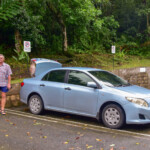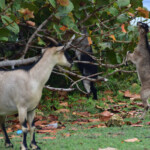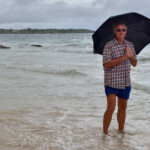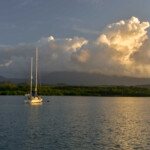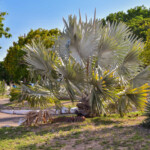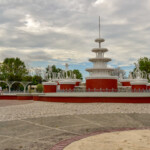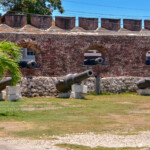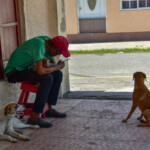Route: Santiago de Cuba-Port Antonio-Port Morant-Kingston
Date: 25/04-10/05/2024
Miles/hours: 186nm/37h
Santiago de Cuba check out
New crew members should register immediately after entering the marina – add them to the crew list (enrolo) – it costs $15 per person. Only then can you walk around the marina and board the yacht. On the first day we visit Santiago de Cuba and visit the May Day picnic (it starts a little earlier). There is a whole alley of tourist offices, a nearby school also exhibits students’ works (only for show – you can’t buy anything). At several stands you can have coffee and drinks and buy small products (coffee, toilet paper and cleaning products). The next day we visit a rum distillery and then go to a nearby beach. From the beach we go for lunch to a very nice restaurant run by a Cuban couple. We are talking to the owner about the situation in Cuba.
We decide to sail on Sunday, April 28, 2024. Previously, we reported our desire to sail without specifying the exact date and time. In the morning it turns out that there is no electricity and it is impossible to pay or issue exit documents. They turn on the electricity around 12. We pay for the remaining days in the marina, the entry fee for 2 people and an officer from Immigration issues us an exit document (Despacho).
Route to Port Antonio, Jamaica
We leave Cuba around 2 p.m. There is no need to pay for exit clearance :-). The wind blows on average 20kn from a half wind, so we sail at 6kn. We sail all night and at 12 noon we enter the Port Antonio marina in Jamaica.
Jamaica
This island is located in the Greater Antilles archipelago and has an area of 11,100 km2 (the country also includes several smaller islands – including the remains of the former capital of Jamaica, Port Royal, completely destroyed by the earthquake in 1692). The country is inhabited by less than 3 million people, mainly of African origin, but a large group also includes Indians and Chinese, whose ancestors were brought here by the British (when Jamaica was their colony) to work in the 19th century.
Jamaicans are very open, friendly and polite, every taunt should not be treated as an attempt to make money from you or a scam. Jamaicans are often curious about us, they want to talk, say hello with a nice “Welcome to Jamaica”, help and make sure you are doing well – as normal, selflessly. Everyone speaks English, although sometimes it is difficult to understand them due to their accent. The colloquial language used on a daily basis is Patois – it is a highly deformed, modified, mixed and simplified English.
Port Antonio Marina
A very nice marina, it is located in concrete Y-booms covered with boards (tide is about 30 cm, so you can skip it). Before entering, we report on VHF channel 16 and the marinero shows us a place to moor. We raise the yellow flag. Q. Marinero hands us 14 documents to fill out. First, a man from the sanitary inspection visits us (he takes 4 completed forms). We can now take down the flag Q. The next officials are customs officers. They take more forms and ask for photocopies of all passports and the yacht document. Of course, I put the yacht stamp on all forms. The next round is Immigration. They also want copies of all passports and the yacht document, and of course stamps :-). I still need to apply for a Crusing Permit to sail around Jamaica – it is valid for 6 months and costs $150 + bank costs. You fill it out online and pay online. Then the proper permit arrives by e-mail, which must be printed in 3 copies, 1 for the yacht, marina and Customs.
The marina costs about $1 per foot of length, $3 per day for garbage, and there is an additional fee for water and electricity.
The marina area is guarded and monitored 24/7. Tap water is safe to drink.
Port Antonio
A small town, many stalls on the street, left-hand traffic. There are almost no tourists in the town. There are no large supermarkets, and the stores that do have supplies are rather poor. Prices are high (even for vegetables).
Tours from Port Antonio
Renting a rather low-class car costs about USD 60 per day. It is worth visiting Reach Falls (unfortunately closed during rain), Long Bay beach – the longest beach in the area – although narrow, and Blue Lagun – a beautiful blue lagoon with a depth of up to 60 m. You can swim in it, but you must wear a vest (rental: 1,000 Jamaican dollars).
Port Morant
Very nice anchorage in the bay. Dolphins live at the entrance to the bay and greet us as we enter and leave. After mooring, the border guard comes to us by boat and fill papers with crew and boat details. There are crocodiles in the bay, so we give up swimming and continue our journey in the morning.
Royal Jamaica Yacht Club
A beautiful club marina with a swimming pool, good toilets, a bar and a small restaurant. Price $1.73 per foot. Plus electricity and water fees. From the marina, it takes about 15 minutes to get to the bus stop to Kingston. The bus (number 98) costs 50-100 JMD. The bus runs at random times. It takes 15 minutes, sometimes an hour. There are warning signs about crocodiles everywhere in the marina. Apparently they can sometimes swim into the marina. The marina’s price includes a swimming pool available 24 hours a day. There is also a bar in the marina where, in addition to drinks, you can order a small dinner. The price ranges from 1,600 to 2,500 JMD.
Transportation in Kingston
Buses operate in Kingston and the surrounding area. They have fixed routes and stops (note – most of them are on request), but we did not notice such an hourly schedule, although local residents probably know it.
Uber operates in Jamaica and works efficiently.
There is also an institution of taxis, in several ways – the classic one, which can be ordered at the marina – rather expensive. Something like the Cuban “taxi colectivo”, i.e. we pick up people along the way and take them to the desired places and the taxi is “negotiated”, i.e. the price can be negotiated. These last two types most often stop at bus stops and honk to “ask a question”. The typical price for such a negotiated taxi is 1,000 JMD.
Kingston
The capital of the island. The largest city in Jamaica. It is divided into 2 main parts – DownTown and UpTown, also known as New Kingston. DownTown is an old district with both old colonial houses and dilapidated ruins. You should not go there after dark or alone. You can get there from the marina by bus 98 or by taxi. At Loop 98 there is a huge market with everything – Coronation Market, where you can buy vegetables and fruit, as well as clothes and industrial items. There are many “Chinese” shops along the street. It’s worth going there, but you have to take good care of your belongings, it’s best to go with a group of friends. A famous place in this district is the Craft Market, a market with local souvenirs – highly overrated, everything in “Jamaican” colors, i.e. green, yellow and black, of Chinese quality.
It is worth visiting Emancipation Park – a nice park with a running track (marked directions and signs with distances) – at the entrance to the park there is a sculpture of a naked couple, and on the premises there is a band shell. The park is located at the beginning of New Kingston. The next point is the Bob Marley Museum – his home, where many memorabilia of the artist are collected. Admission with guide is $25. We gave up and looked at it from the outside. In New Kingston there is Devon House – the estate of the first black millionaire in Jamaica. In the park surrounding it, there are many souvenir shops, restaurants and an ice cream parlor with local flavors of ice cream (there are also traditional flavors) – a ball costs 700 JMD.
When it comes to supplies, New Kingston has a large, well-stocked sailing shop (Durae’s Boat Sales & Marine Supplies on Roswell Terrase – unfortunately expensive), large grocery stores, and industrial stores. You need to know about most of these stores because they usually have no signs (except maybe grocery stores).
Blue Mountain Coffee Plantation
It is worth going on a trip to the Blue Mountains to a coffee plantation (UCC Blue Mountain Coffee Craighton Estate in Jamaica). The plantation is owned by a Japanese company.
The guided tour costs USD 85 per person, and the price includes round-trip transportation, a very nice guide (Katrin), coffee tasting on a plantation with a rum cake, entry fees, pickup and delivery from a selected point in the center of Kingston. (https://www.getyourguide.pl/kingston-jamajka-l322/znajrka-szlakow-blue-mountain-t30485/). On the way, we stop at a viewpoint and Katrin tells us what is worth visiting in Kingston.
Coffee is grown on the slopes of the mountain, and the entire process of collecting and sorting the beans is done by hand. We visit the plantation with a guide who talks very interestingly about coffee cultivation, the species and process of coffee production and its types. The presentation is followed by a tasting of Blue Monuntain coffee. In the shop at the plantation you can buy coffee at affordable prices (you can pay in USD or local currency). You can choose from various package sizes and coffee beans or ground coffee.
Port Royal
The former capital of the island was almost completely submerged during the 1692 earthquake. Unfortunately, you cannot dive in the sunken city – it is a UNESCO monument – only scientists and people with special permission are allowed to enter. The town itself is small – there is a hotel, a fort at the end of the peninsula (visit USD 15), a few pubs, a beach and a terminus for the 98 bus to Kingston (it terminates at Coronation Market).




